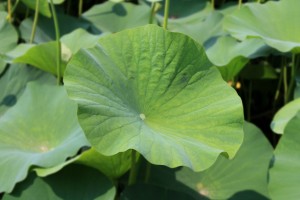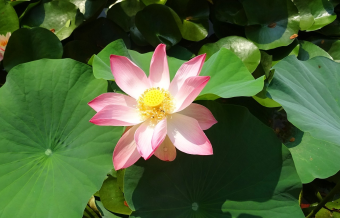
Superhydrophobic? What’s that? A word in the Mary Poppins musical?
There is much interest in a behavior of the lotus plant. It is the ability to shed water completely and take surface detritus along with it. This superhydrophobic property had been observed in nature. But at first it could not duplicated in the lab. In that setting, the leaves were wet.
Superhydrophobic: But Not In the Lab?
After some time, it was found even wetted leaves would produce the effect in the presence of vibrations, such as those from a stereo speaker. This was evidence energy, usually vibratory energy, was required. It lifts water out of the spaces between the cone-like waxy protrusions found on the surface. This property is now used to develop biomimetic objects.

My Educated Guess
In even the tallest trees water rises up the trunk by means of capillary action. Capillaries are very thin tubes for liquid transport. The waxy protrusions on the surface of a lotus leaf reminds the author of capillaries. The dimension of a capillary in a tree is on the order of 25 micrometers (1/1,000th inch). The distance between protrusions of a lotus leaf runs approximately 10 to 25 micrometers.
The two actions seem similar but there is a difference. The capillary tubes of a tree are made of cellulose. This has a water loving or hydrophilic surface. The protrusions of the lotus leaf are waxy. This is a water hating hydrophobic surface. Water on the surface of a lotus leaf is not encouraged to rise. However, once it has risen via the vibrations, neither is it encouraged to fall back to its former location at the surface. it twas the stronger force of the water striking the leaves that allowed the water to penetrate the protrusions in the first place.
Is the reader able to understand basic trigonometry and algebra? If so, enjoy this not entirely unrelated Durham University presentation video.
Note: You might also enjoy Buttercups Glow at Night
References:
- Cazadero Performing Arts Camp: Nature Program: Trees & Capillary Action
- Duke University: In FocusGood Vibrations
- Teach Engineering: Lesson: Superhydrophobicity — The Lotus Effect
- National Geographic: New Water-Repellent Material Mimics Lotus Leaves
- YouTube: Lotus Effect (video)

Didn’t know this about lotus leaves. That suggests so many possibilities for self cleaning surfaces. Would love that!
Capillary action only moves water up a tree to a certain distance. https://water.usgs.gov/edu/capillaryaction.html
Yes, ordinarily it does.